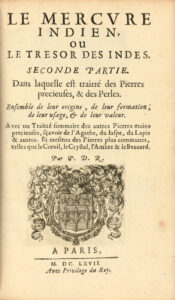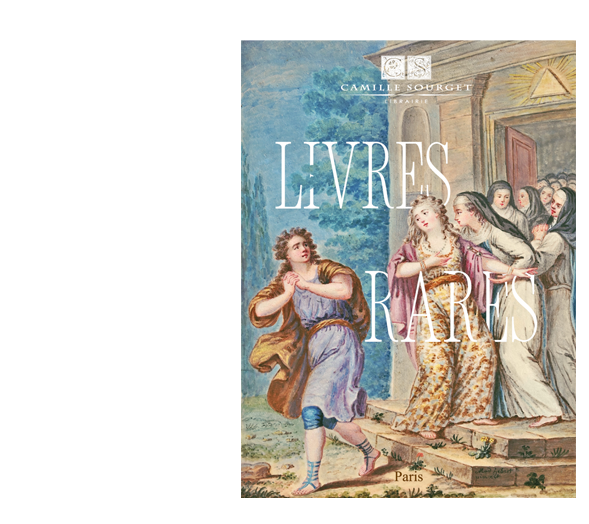Paris, 1667.
2 parts in 1 volume 8vo [178 x 111 mm] of: (8) ll., 64 pp. ; (8) ll., 176 pp. (occ. stains, ink stain on 1st title). Contemporary brown calf, spine on 5 raised bands (corners and joints restored), sprinkled edges. Binding somewhat used otherwise good copy.
Rare first edition, first issue, of this much esteemed and sought-after mining and metallurgical treatise by the Parisian goldsmith P. de Rosnel (« orfèvre ordinaire du roy »).
Réf : Sinkankas 5569 (extensive description) ; Sabin 73297 ; Ferguson, II, 295 ; Cp. Duveen p. 516 ; Caillet 9597 ; Hoover 692; Sinkankis 5569.
Divided in two parts, “The first part of the much esteemed and sought for work by the Parisian goldsmith is a mining and metallurgical treatise in which gold, silver, and mercury are described in respect to their mines and methods of mining, purification of ores by smelting or otherwise, and refinement of the metals. Special emphasis is laid upon the New World…. [The second part] precedes the publication of the standard method of pricing as described by J. E. Tavernier, Les Six voyages, 1767, often cited as the earliest publication of the rule, and by far anticipates the similar rule published by David Jeffries in his A Treatise on Diamonds and Gems, 1750” (Sinkankis).
The 2nd part is of gemological interest, dealing with the origin of gemstones and describing the diamond, ruby, spinel, sapphire, topaz, emerald…, pearls…, agate, jades and massive ornamental stones ; at the end, a chapter devoted to valuation of gems presenting realistically and in detail the method by which values are assigned to cut gems.
As the author remarks “The most perfect [pearls] are fished in the Persian Gulf, between the island of Hormuz & Basra, near Qatifa, Gombroon & Julfar” (p. 35).
“This was long considered one of the best manuals of the gold- and silversmith’s trade. Rosnel rejected the alchemists and displayed a profound knowledge of metals and alloys” (Hoover). ”
Pierre de Rosnel was goldsmith-in-ordinary to King Louis XIII of France, otherwise little is known of him. In the final part of Le mercure indien he “provides a mathematical system for adjusting prices of diamonds upwards at a steepening rate with increasing weight” (Sinkankas), preceding the publication of the standard method of pricing as described by Tavernier.
Dedicated to Le Tellier, with his engraved arms on both titles.
A precious copy preserved in its contemporary binding.
Provenance : old name on title.

![Le Mercure Indien, ou le Trésor des Indes. Première partie dans laquelle est traitté de l’Or, de l’Argent & du Vif-argent, de leur Formation, de leur Origine, de leur Usage & de leur Valeur. Avec une explication sommaire des Titres de l’Or & de l’Argent, & de leur Affinage. Dédié à Monseigneur Le Tellier.- [Suivi de] : Le Mercure Indien ou le Trésor des Indes, seconde partie. Dans laquelle est traitté des Pierres précieuses, & des Perles. Ensemble de leur origine, de leur formation, de leur usage, & de leur valeur. Avec un Traitté sommaire des autres Pierres moins précieuses, sçavoir de l’Agathe, du Iaspe, du Lapis & autres. Et mesmes des Pierres plus communes, telles que le Corail, le Crystal, l’Ambre & le Bezoard.](https://www.camillesourget.com/wp-content/uploads/2023/03/020b-ywsmb.jpg)
![Le Mercure Indien, ou le Trésor des Indes. Première partie dans laquelle est traitté de l’Or, de l’Argent & du Vif-argent, de leur Formation, de leur Origine, de leur Usage & de leur Valeur. Avec une explication sommaire des Titres de l’Or & de l’Argent, & de leur Affinage. Dédié à Monseigneur Le Tellier.- [Suivi de] : Le Mercure Indien ou le Trésor des Indes, seconde partie. Dans laquelle est traitté des Pierres précieuses, & des Perles. Ensemble de leur origine, de leur formation, de leur usage, & de leur valeur. Avec un Traitté sommaire des autres Pierres moins précieuses, sçavoir de l’Agathe, du Iaspe, du Lapis & autres. Et mesmes des Pierres plus communes, telles que le Corail, le Crystal, l’Ambre & le Bezoard. - Image 2](https://www.camillesourget.com/wp-content/uploads/2023/03/020b-RvkIj.jpg)
![Le Mercure Indien, ou le Trésor des Indes. Première partie dans laquelle est traitté de l’Or, de l’Argent & du Vif-argent, de leur Formation, de leur Origine, de leur Usage & de leur Valeur. Avec une explication sommaire des Titres de l’Or & de l’Argent, & de leur Affinage. Dédié à Monseigneur Le Tellier.- [Suivi de] : Le Mercure Indien ou le Trésor des Indes, seconde partie. Dans laquelle est traitté des Pierres précieuses, & des Perles. Ensemble de leur origine, de leur formation, de leur usage, & de leur valeur. Avec un Traitté sommaire des autres Pierres moins précieuses, sçavoir de l’Agathe, du Iaspe, du Lapis & autres. Et mesmes des Pierres plus communes, telles que le Corail, le Crystal, l’Ambre & le Bezoard. - Image 3](https://www.camillesourget.com/wp-content/uploads/2023/03/020a-7lM3q.jpg)
